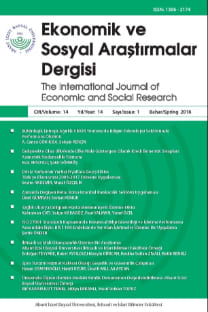TÜRKİYE'DE KUR REJİMİ UYGULAMASI VE ENFLASYON İLİŞKİSİ ÜZERİNE BİR ANALİZ
Bu çalışmada Türkiyedeki enflasyon ile ABD Doları ve Euro-bölgesi parabirimi Euroya ait döviz kurları arasındaki muhtemel ilişkinin niteliğiincelenmiştir. Değişkenler arasında uzun dönemli bir ilişkisinin olup olmadığınıgörmek için eşbütünleme (koentegrasyon) analizi kullanılmıştır. Uzun dönemliilişkinin yönünü ve kısa dönemdeki etkileri görebilmek için de Vektör HataDüzeltme Modeli (VECM) analizi kullanılmıştır. Ulaşılan sonuçlara göreTürkiyede fiyat düzeyi ile ABD döviz kuru (USD/TRY) ve Euro kuru(EUR/TRY) arasında uzun dönemli ilişki bulunmaktadır ve bu ilişkinin yönükurlardan fiyat düzeyine doğru işlemektedir. Sonuç olarak döviz kurlarıyükseldikçe ülkemizdeki enflasyon da artmaktadır.
AN ANALYSIS ON THE EXCHANGE RATE REGIME IN TURKEY AND ITS EFFECT ON INFLATION
In this study the relationship between price levels in Turkey and enxchange ratesof US Dollar and Euro has been investigated. Cointegration analysis has beenused in order to see the presence of long-run relationship between the variables.To see the direction of the relationship and the short-run dynamics between theselected variables, a Vector Error Correction Model (VECM) analysis has beenutilized. The results show that there is a long-run equilibrium relationshipbetween price levels in Turkey and the two exchange rates, (USD/TRY) and(EUR/TRY). The VECM estimates reveal that long run causality runs from theExchange rates to inflation. As a result, the higher the exchange rates, the higherthe inflation in Turkey.
___
- Alacahan, N. D. (2011) Enflasyon, Döviz Kuru İlişkisi Ve Yansıma: Türkiye, İ.Ü. Sosyal Bilimler Dergisi, Sayı: 2011(1), 49-56.
- Albuquerque, C. R. ve Portugal M. S., (2005) Exchange Rate and Inflation: A Case of Sulkiness of Volatility, http://www8.ufrgs.br/ppge/pcientifica/2005_01.pdf, (Erişim: 01.13.2013).
- Cooper, R. N. (1999) Exchange Rate Choices, Harvard Institute of Economic Research Working Papers, No: 1877, 100-123.
- Davidson, R., and MacKinnon, J.G. (1993) Estimation and Inf erence in Econometrics, Oxford University Press, Oxford.
- Domaç, İ., Peters, K. ve Yuzefovich Y. (2001) Does the Exchange Rate Regime Affect Macroeconomic Performance? Evidence From Transition Economies, Policy Research Working Paper, No: 2642, 1-29.
- Engle, Robert F. and Clive W. J. Granger (1987). Co-integration and Error Correction: Representation, Estimation and Testing, Econometrica, 55 (2), 251-276.
- Granger, C. W. J. (1988) Some Recent Development in a Concept of Causality Journal of Econometrics, 39(1-2), 198-211.
- Gül, E. ve Ekinci, A. (2006) "Türkiyede Enflasyon ve Döviz Kuru Arasındaki Nedensellik İlişkisi:1984-2003", Anadolu üniversitesi Sosyal Bilimler Enstitüsü Dergisi, Cilt. 6, 91 105.
- Imimole, B. ve Enoma, A. (2011) Exchange Rate Depreciation and Inflation in Nigeria (1986-2008) Business and Economics Journal, No: 2011: BEJ-28.
- Işık, N., Acar, M. ve Işık, H. B. (2004) Enflasyon ve Döviz Kuru İlişkisi: Bir Eşbütünleşme Analizi SDÜ İİBF Dergisi, Cilt: 9, Sayı: 2, 325-340.
- Johansen, S. (1988) Statistical Analysis of Cointegration Vectors, Journal of Economic Dynamics and Control, Sayı 12, 231-255.
- Johansen, S. ve Juselius, K. (1990) Maximum Likelihood Estimation and Inference on Cointegration with Applications to the Demand for Money, Oxf ord Bulletin of Economics and Statistics, 52(2) 169210.
- Kasman S. ve Ayhan, D. (2006) Macroeconomic Volatility under Alternative Exchange Rate Regimes in Turkey, Central Bank Review, Sayı: 2, 37-58.
- Kesavarajah, M. (2010) A Multivariate Cointegration Analysis of Inflation in Sri Lanka, Department of Economics, University of Colombo, Sri Lanka.
- OANDA Rates/www.oanda.com (Erişim:16.12.2012).
- Peker, O. Ve Görmüş, Ş. (2008) Türkiyede Döviz Kurunun Enflasyonist Etkileri SDÜ İİBF Dergisi, C.13, S. 2, 187-202.
- Sahadudheen, I. (2012) A Cointegration and Error Correction Approach to the Determinants of Inflation in India, International Journal of Economic Research, No: 3(1), 105-112.
- Şahinoğlu, T., Özden, K., Başar, S. ve Aksu, H. (2010) Türkiyede Enflasyonun Oluşumu: ARDL Yaklaşımı, Sosyoekonomi, Sayı:2010-1/100102, 28-46.
- Sever, E. ve Mızrak, Z. (2007) Döviz Kuru, Enflasyon ve Faiz Oranı Arasındaki İlişkiler: Türkiye Uygulaması SÜ İİBF Sosyal ve Ekonomik Araştırmalar Dergisi, C.13, 265-283.
- Taşdemir, M. ve Aslan, M. (2009) Uncertainity Spillovers between Exchange rates and Inflation: Evidence From Turkey, Anadolu International Conf erence In Economics, June 17-19, Eskişehir Turkey.
- TCMB Elektronik Veri Dağıtım Sistemi, http://evds.tcmb.gov.tr/ (Erişim: 13.12. 2012).
- Terzi, H. ve Kurt, S. (2007) Türkiyede Dolarizasyon Sürecinde Döviz Kuru ve Enflasyon İlişkisi Ekonomik Yaklaşım, C.18, S. 64, 1-22.
- Terzi, H. ve Zengin, H., (1996) Türkiyede Kur ve Enflasyon Arasındaki Nedensellik İlişkisi Üzerine Bir İnceleme M.Ü. İstatistik ve Ekonometrik Araştırma ve Uygulama Merkezi Dergisi, Sayı: 1, 3- 15.
- Vicente, C. (2007), Exchange Rate and Consumer Prices in Mozambique: A Cointegration Approach, Instituto de Estodos Sociais e Economicos (IESE), No:40, 1-24.
- Zaferiou, E. A., Theodoros, C. K., ve Spyridon C. S. (2008) An Empirical Study of the Relationship between the Real Exchange Koruna-Dollar Rate and Economic Fundamentals for Czech Republic and US, International Conf erence on Applied Economics-ICOAE, 945-951.
- ISSN: 1306-2174
- Yayın Aralığı: 2
- Başlangıç: 2005
- Yayıncı: Abant İzzet Baysal Üniversitesi İktisadi ve İdari Bilimler Fakültesi
